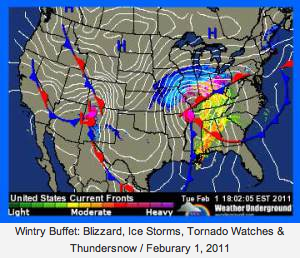Two-thousand miles across. A hundred million people in harm’s way. Blizzard warnings in at least nine states. Tornado warnings in others. Ice storms sealing whole cities in shells of slick an inch thick. Snow tallies measured in feet. Snow drifts sculpted into frozen dunes. Winds 30-40-50-even 60 mph driving temperatures into negative double-digit insti-frostbite territory. Twenty-five foot waves on Lake Michigan, powerful enough to turn Chicago’s Lake Shore Drive “into an ice-skating rink” (or, as it turned out, a parking lot…)
And yet we saw it coming, so it won’t be quite so bad. For the past couple of days, people have been stocking up on everything from salt and shovels to groceries and fireplace logs. Snow plows have been pre-positioned, and flights, by the thousands, canceled in anticipation by the airlines. Warming shelters have been opened and schools closed. The entire cast and crew of The Weather Channel is “in position,” ready to freeze for the camera so we don’t have to…
Yes, there will be car accidents, stranded commuters, power outages, busted roofs, broken ankles, frostbitten fingers and toes, electric heater fires, and probably a few death-by-shoveling heart attacks. Municipal budgets, already struggling, will buckle under the costs. But mostly we will be alright.
Not so the victims of floods in Australia, Brazil, Pakistan, Nigeria, Sri Lanka, Germany, Italy, Mexico, England, Costa Rica, the Philippines and so many other places where record rains over the last year have led to tragedy beyond imagining. Normally quiet—or at least predictable—rivers have burst their banks, roaring Hulk-like over the land, submerging crops, stranding wildlife and sending millions of people scrambling for shelter, their lives forever altered, their hopes and dreams literally drowned. And when it wasn’t rivers on a rampage, it was the saturated ground itself that gave way, unleashing killer mudslides, burying thousands alive.
The future could be even soggier. In the short-term, Australia’s rain-wracked state o fQueensland is currently bracing for Yasi “one of the most devastating cyclones on record.” A little harder to pin down schedule-wise is something called an ARk storm, due to slam into the California, dumping up to 10 feet of rain over several weeks andcosting, when all is said and done, three times as much as a big earthquake: an estimated $725 billion.
ARk storms have happened before, most recently 150 years ago when it rained for nearly two months straight. So many livestock drowned, ranchers traded in branding irons for plows in the aftermath and became farmers. In the USGS scenario, one of the world’s great food baskets, the Central Valley, fills up like a giant bathtub, 300 miles long and 20 miles wide.
Serious flooding also occurs in Orange County, Los Angeles County, San Diego, the San Francisco Bay area, and other coastal communities. Windspeeds in some places reach 125 miles per hour, hurricane-force winds. Across wider areas of the state, winds reach 60 miles per hour… Flooding evacuation could involve 1.5 million residents in the inland region and delta counties.
—Overview of the ARkStorm Scenario
The “AR” in “ARk” stands for “atmospheric rivers.” We know them as the Pineapple Express or the Alberta Clipper—conveyer belts of moisture laden air. Now, with more moisture in the air, they, too, have burst their banks. The floods above our heads beget the floods here on the ground.
An intricate weave of ocean surface temperatures driving global weather patterns—La Nina, El Nino and a slew of acronyms only meteorologists can keep straight—combined with man-made changes to the land—deforestation, development, crumbling, inadequate infrastructure—determine how severe damage will be. But clearly more people are in harm’s way. And more harm is on the way.
The climate is in shifting. Climate change is a done deal. Umbrellas for everybody…and some shovels, too.
- and more!










